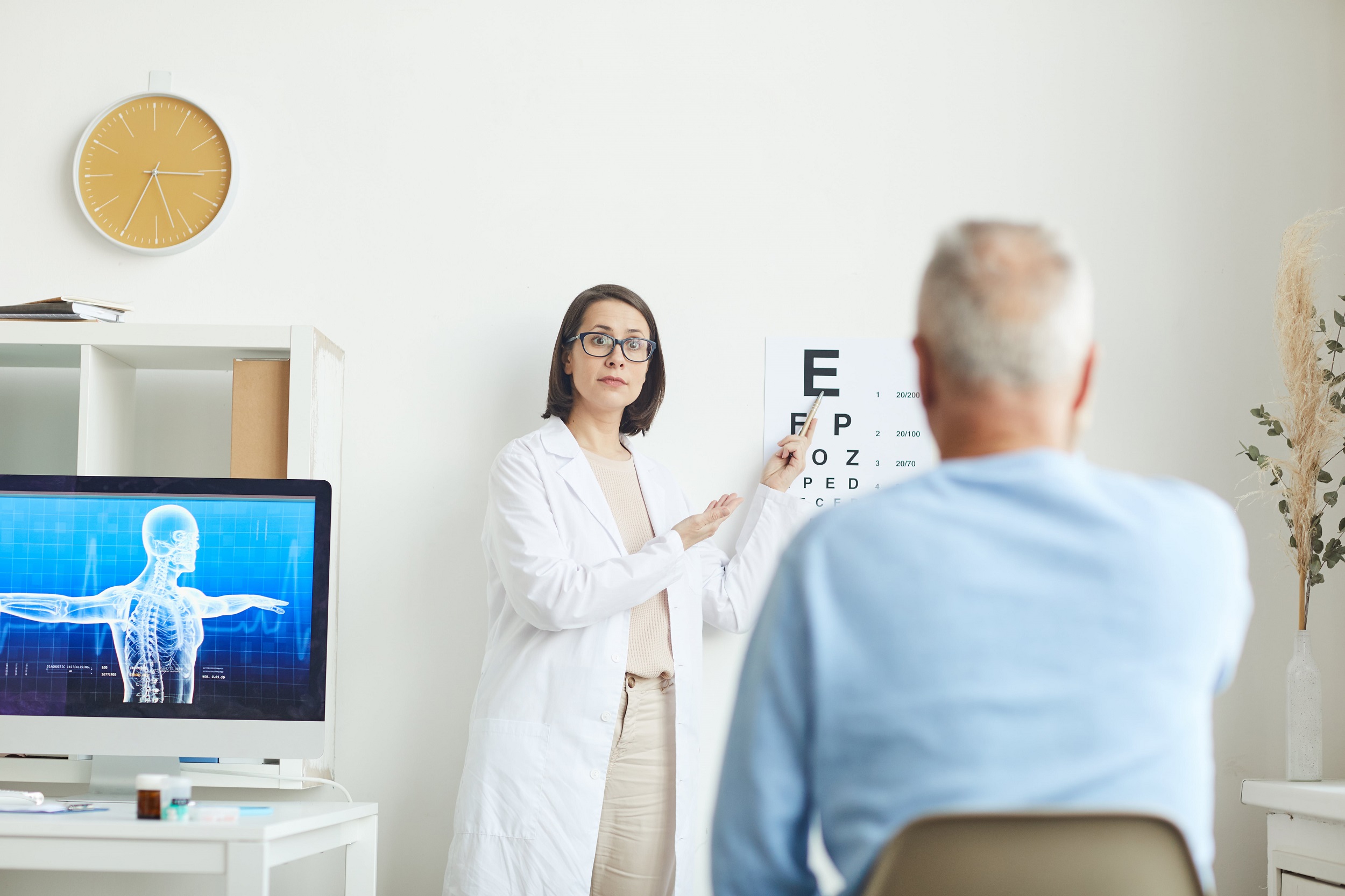“20/20” is a word that almost everyone is familiar with. Many individuals consider it a source of pride. “I have 20/20 eyesight, according to my doctor.” If your vision is less than 20/20, such as 20/200, on the other hand, maybe a source of tremendous stress and anxiety. I’ll explain what these phrases truly imply in this discussion.
The term “normal” eyesight is defined as 20/20 vision. Assume you have two persons, one with 20/20 vision and the other with 20/60 vision. The 20/60 line is the smallest line of letters that the second person can see at a distance of 20 feet. The first person with “normal” 20/20 vision, might see the identical line from 60 feet away. The 20/60 letters are 3 times the size of the 20/20 letters, thus someone with normal vision may see a 20/60 letter from 3x’s the distance as someone with 20/60 vision.
Even with 20/20 vision, you should get your eyes tested on a regular basis to ensure that your acuity and eyesight remain as good as possible for as long as feasible. Because there are various variables that contribute to vision difficulties, frequent eye examinations may discover possible problems early and, if necessary, cure them before they worsen.
Based on your glasses prescription, eye physicians can typically predict what your uncorrected VA will be. This is most effective for nearsightedness. In other words, for every half step up in glasses prescription (i.e. -1.00 vs. -1.50), one can see one less line on an acuity chart.
A prescription of – 1.00 equals 20/40 vision, -1.50 equals 20/50 vision, and so on. Anyone with an anatomically healthy eye, that is, one that is free of illness, should be able to correct their vision to 20/20 using glasses or contact lenses. It’s worth noting, though, that a person’s best-corrected acuity may not be 20/20 but have no visible evidence of illness on rare occasions.
Farsightedness is more difficult to assess since it is influenced by a variety of other variables, such as age and concentrating ability.
20/60 Vision can be considered visually impaired
20/20 eyesight is perfect vision. When a person’s best-corrected acuity in their better eye is less than 20/200, they are legally blind. If a person’s better eye’s side vision is restricted to 20 degrees or less, they are legally blind. Even if a person is legally blind, some vision may be beneficial and helpful in daily life.
You may be considered visually impaired if neither of your eyes can see better than 20/60 vision without the use of glasses or contacts. Visual impairment can also be determined by poor night vision, minimal side vision, double vision, and vision loss in one eye.
Low vision is a phrase used to describe the vision that is below normal (20/70 or worse) that cannot be corrected with regular glasses. Blindness is not the same as low vision. Low-vision individuals may make use of their eyesight. Low eyesight, on the other hand, might make it difficult to conduct everyday tasks like reading or driving. Low Vision is defined as 20/70 vision. However, regardless of the exact acuity, someone has low vision if their diminished eyesight hinders their regular activities.
Visual impairment is defined as diminished vision that cannot be corrected. Uncorrectable vision refers to vision that cannot be corrected further using eyeglasses or contact lenses; it does not refer to vision without glasses.
Visual impairments come in a variety of shapes and sizes, with varied degrees of severity. Visual acuity isn’t a good indicator of a person’s vision issues on its own. Someone with moderate 20/60 vision may have trouble functioning, but someone with poor acuity (20/200) may not have any issues with everyday tasks.
How is 20/60 Vision measured?
The Snellen acuity chart is the traditional chart of large and small letters, referred to as “optotypes” in this context. The chart is made up of 11 lines of block letters, with the top row starting with a huge single letter. As you go from top to bottom, the number of letters on each row increases. The letters gradually shrink in size, providing for more letters on each succeeding line.
When assessing visual acuity, the patient closes an eye and reads the letters on the chart from top to bottom, starting at the top and working down. Visual acuity in the uncovered eye is determined by the lowest row of letters that the patient correctly reads. The test is performed with the opposite eye, and then both eyes at the same time.
The quality of your vision will be determined by the results of your acuity test (chart reading). The findings of your eyesight (acuity) will be presented as a fraction. Each row has fractions to the left of it that indicate how well that you see.
If you are able to get the letters to the fifth line, for instance, your vision would be described as 20/40; if you could read all the way to the seventh line, it would be described as 20/25.
Consider the figures in feet while interpreting your reading. A person with 20/60 vision, for example, can read at 20 feet what someone with normal vision might see at 60 feet.
To drive a vehicle in the United States without corrective glasses, you must have a vision score of 20/40 or above. Visual acuity of 20/200 (or worse) qualifies someone as legally blind.
20/10 – When the numbers decrease, it means you have superior to average vision. You can see well at 20 feet away what a person with “normal” vision can see from 10 feet away while using an eye chart.
Conditions that can result in 20/60 vision
Myopia is another term for nearsightedness. When a person is near to an item, they can see it clearly, whereas things at a distance look blurry. Nearsightedness affects roughly 30% of the population and may be readily be corrected with contact lenses or glasses.
Farsightedness, sometimes called hyperopia, is the polar opposite of nearsightedness. Items that are far away can be seen clearly, while objects that are near to them are hazy. Like myopia, this is also readily curable.
Astigmatism is a condition in which the surface of the cornea or lens is not spherical, leading your eyes to focus on two spots rather than one. This may result in eye strain, soreness, headaches, blurred/distorted vision, and night vision issues, among other things. Astigmatism is readily treated with the right contacts or eyeglasses.
Presbyopia is a condition in which your eye’s lens changes and becomes less flexible, this makes it harder to focus on close objects. This may happen between the ages of 40 and 60. There are numerous visual changes between the ages of 40 and 60, but they grow more severe beyond that.
People with diabetes may notice changes in their eyesight and/or visual functionality on a daily basis as a result of the condition. Diabetic retinopathy is a condition in which the blood vessels that supply the retina acquire small, irregular branches that leak. This may cause visual problems and, over time, may cause serious retinal damage. Although laser techniques and surgical therapies may slow the growth of diabetic retinopathy, the most crucial step in treating it is to control blood sugar.
The optic nerve is damaged by glaucoma. This is most usually caused by an increase in internal pressure in the eye as a result of issues with fluid flow or drainage inside the eye. It may also happen when the intra-ocular or internal pressure of the eye does not rise (normal-tension glaucoma), but the optic nerve does not get adequate blood flow. The most common kind of glaucoma has no early symptoms but impairs side (peripheral) vision and trouble with night vision are the earliest evidence of damage. It may be treated with medications or, in certain cases, surgery to reduce vision loss if detected early.
A cataract is a clouding of the lens within the eye, which may affect one or both eyes. The clouding prevents light from reaching the retina in the rear of the eye, leading to vision loss. Aging, long-term exposure to UV radiation from the sun, injury, sickness, and hereditary problems are all possible causes. A cataract may be surgically removed if the eye is healthy. The eye is usually implanted with an intraocular lens implant, and vision is restored. In otherwise healthy eyes, cataract surgery has a high success rate. Cataract surgery, on the other hand, is not always feasible for patients who have other eye disorders. To make the most of their residual eyesight, these folks may need low-vision rehabilitation.
Macular Degeneration is a degeneration of the central section of your retina, which is the region in the back of your eye that receives visual images and conveys them to the brain. A gray/black dot will appear in the middle of a person’s vision, which will progressively become bigger. This illness is the most common cause of eyesight loss and is irreversible; however, medication may help to decrease the symptoms.
Workplace eye injuries are rather prevalent. According to the National Institute for Occupational Safety and Health (NIOSH), around 2,000 employees in the United States suffer work-related eye injuries that need medical attention every day. However, eye specialists and safety experts think that proper eye protection may reduce the severity of or even avoid 90% of these accidents.
What can you do if you have uncorrectable 20/60 vision?
To drive a vehicle in the United States without corrective glasses, you must have a visual acuity of 20/40 or above. Visual acuity of 20/200 (or worse) qualifies someone as legally blind. Therefore with 20/60 vision, you will either need a visual aid to get your vision to 20/40 or your license will be restricted.
For persons who have lost their eyesight, low vision rehabilitation is the gold standard of therapy. If you or someone you know has a vision problem, speak with your optometrist about low vision treatment. Low vision therapies provided by an optometrist may assist persons with low vision to reclaim their independence and enhance their quality of life.
People with impaired vision may acquire a multitude of ways to assist them to carry out everyday tasks with the vision they have left. Educational and vocational counseling, low vision occupational therapy, rehab training, and other services are available via government and commercial programs.
If you have best-corrected 20/60 vision or you’re struggling to do your daily activities efficiently call one of our low vision specialists that are near you for an appointment.
FAQs
Is 20/60 vision OK for driving?
If the person can meet additional vision and driving standards, many jurisdictions, including the United States, consider a visual acuity of 20/60 to be sufficient for driving without the need for corrective glasses. Many states in the US require 20/40 vision to be able to drive without restrictions. But it’s important to keep in mind that driving is a difficult endeavor that calls for more than simply sharp vision. Here are a few things to think about:
- Legal Requirements: Depending on the locality and the type of license (such as an ordinary driver’s license, a commercial driver’s license, etc.), different visual acuities may be needed to obtain a driver’s license. The specific rules in your local jurisdiction should be checked because they may be different.
- Peripheral Vision: For safe driving, having adequate peripheral vision is crucial. Reduced peripheral vision might make it more difficult for you to see other cars, people walking nearby, and other nearby objects. This might be crucial to visual acuity.
- Night Vision: Some people may have good daytime visual acuity but have trouble seeing well at night. Driving at night or in low light might be particularly challenging in this situation.
- Depth perception is essential for determining the distance between your car and other roadside items. Your ability to drive safely may be impacted by problems with depth perception.
- If your vision can be corrected with glasses or contact lenses to 20/20, you should wear corrective lenses.
How common is 20/60 vision?
Depending on the population and age group under consideration, the prevalence of 20/60 vision can change dramatically. Typically, 20/60 vision is regarded as a degree of visual acuity that, for some people, may necessitate the use of corrective lenses in order to meet the requirements for unrestricted driving.
Here are a few broad observations regarding the predominance of 20/60 vision:
- Age-Related Changes: People’s vision may inevitably get worse as they get older. Presbyopia, which causes difficulties focusing on close objects, can become increasingly prevalent in middle-aged and older people, potentially resulting in vision as poor as 20/60 or worse without corrective lenses.
- Myopia and Hyperopia: If refractive problems like myopia (nearsightedness) and hyperopia (farsightedness) are not treated with glasses or contact lenses, they can result in vision of 20/60 or worse. These disorders are quite prevalent, with age and geographic differences in occurrence.
- Other Eye problems: As people age, other eye problems like cataracts, glaucoma, and macular degeneration become more common and can also impact visual acuity.
- With the aid of corrective lenses, such as glasses or contact lenses, many people with refractive problems can attain 20/20 vision or better.
What’s the worst eyesight you can have to drive?
The worst eyesight you can have to legally drive varies by country and region, as different places have their own regulations and requirements for obtaining a driver’s license. These requirements typically consider both visual acuity (clarity of vision) and visual field (peripheral vision).
What prescription is 20/60?
A visual acuity of 20/60 means that at a distance of 20 feet, you can see objects as clearly as a person with normal vision can see them at 60 feet. In terms of a prescription for glasses or contact lenses, a prescription of -2.00 diopters (abbreviated as -2.00 D) is often used as a rough approximation for 20/60 vision.
What is 20/60 in Snellen?
In Snellen notation, 20/60 vision means that a person can see at 20 feet what a person with normal vision can see at 60 feet. This indicates that the person’s vision is less sharp than someone with 20/20 vision. In Snellen eye charts, the letter sizes are calibrated to represent the size they should appear to a person with normal vision at a specified distance.
What is an example of 20/60 vision?
To provide an example of what someone with 20/60 vision might experience, imagine looking at an eye chart under specific conditions. In this case, someone with 20/60 vision would be able to read the same line of an eye chart at 20 feet that a person with normal 20/20 vision could read at 60 feet.
Is 20/60 better than 20/100?
Yes, 20/60 vision is better than 20/100 vision. In the Snellen visual acuity system, the first number represents the test distance (20 feet), and the second number represents the distance at which a person with normal vision can read the same line of letters on the eye chart.
Is 20/30 vision better than 20/60?
Yes, 20/30 vision is better than 20/60 vision. In the Snellen visual acuity system, the first number represents the test distance (20 feet), and the second number represents the distance at which a person with normal vision can read the same line of letters on the eye chart.
What is 20/60 vision in meters?
To convert 20/60 vision to meters, you can use the fact that 1 meter is approximately equal to 3.28 feet.
So, if 20/60 vision means you can see at 20 feet what a person with normal vision can see at 60 feet, you can convert that to meters as follows:
- 20 feet ≈ 6.10 meters
- 60 feet ≈ 18.29 meters
So, 20/60 vision means you can see at 6.10 meters what a person with normal vision can see at 18.29 meters. This indicates reduced visual acuity compared to normal vision.














